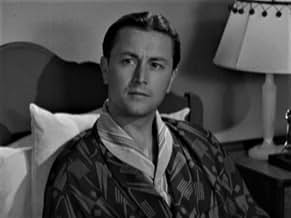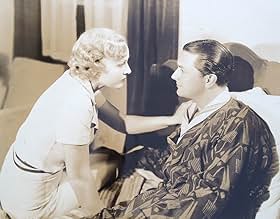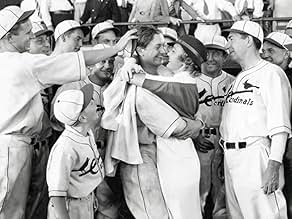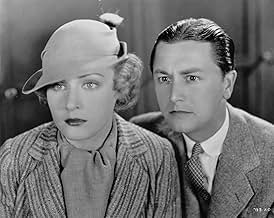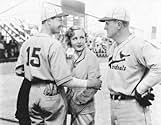अपनी भाषा में प्लॉट जोड़ेंA losing baseball team starts losing its players to strange killings, and the team's new pitcher takes a swing at finding the killer.A losing baseball team starts losing its players to strange killings, and the team's new pitcher takes a swing at finding the killer.A losing baseball team starts losing its players to strange killings, and the team's new pitcher takes a swing at finding the killer.
Joe Sawyer
- 'Dunk' Spencer
- (as Joe Sauers)
Ernie Alexander
- Dick
- (बिना क्रेडिट के)
Brooks Benedict
- Game Radio Announcer
- (बिना क्रेडिट के)
Bruce Bennett
- Man on Ticket Line
- (बिना क्रेडिट के)
Red Berger
- Baseball player
- (बिना क्रेडिट के)
फ़ीचर्ड समीक्षाएं
The only reason to see this picture is for its historical value. You can trace the beginnings of some Hollywood careers as the film contains some famous movie names. It is also an interesting commentary on how sophisticated Major League baseball has become in the ensuing years; major league rules, regulations and business structure - how innocent and unstructured life and baseball were years ago.
It's a nice vehicle for Robert Young and the lovely Madge Evans but the story is trite and predictable. There are numerous plot holes to navigate but if you can just overlook them you can make your way through a harmless 69 minutes.
It's a nice vehicle for Robert Young and the lovely Madge Evans but the story is trite and predictable. There are numerous plot holes to navigate but if you can just overlook them you can make your way through a harmless 69 minutes.
Death on the Diamond (1934)
The title and plot sound serious but this is a corny, lighthearted spin on murder and racketeering in America's pastime. And leading man Robert Young plays it so breezy you can't quite take his pitching, or his romancing, seriously.
Which is all intentional, no doubt. This is purely entertainment, and in the style of a B-movie at the time, along the lines of many of the murder mystery series that were so popular. The acting and the plots are functional, and fun enough to work, and there is one main hook to keep you interested. Or at least me interested in this one. I knew after ten minutes the movie had no real merit, but I watched it anyway, just to see how they handled the idea.
The idea is sensational: a famously bad baseball team (the St. Louis Cardinals) is surprisingly good thanks to their new sensational pitcher. So a notorious gambler is going to lose big money, and an aggressive businessman is going to fail to buy the team at the end of the season. But only if, in fact, the Cardinals continue to win. So key players start to die. Yes, they are murdered in all kinds of ways. It's a terrifying idea, and I suppose feasible even if preposterous, and you do wonder what the league, and the players, and the fans, and the cops would do.
Well, it is all handled rather lightly. The show must go on, and baseball must be played. Even as bodies are found in the middle of a game, there is no sense that murder trumps nine innings of play, and you really do have to roll your eyes. And then the characters go along with it, too, showing no real fear that they might be next. The actual killers are never really seen—just a shadow, or the barrel of a gun—and so the suspense is deliberately kept low key.
Baseball fans, and baseball movie fans, will no doubt find something to like here. There is a bit of actual footage at the St. Louis baseball stadium, and quite a few actual ballplayers are used in background roles. Young isn't a completely awful pitcher, but you can see when he's pitching in front of a projected backdrop at the studio. There is one little baseball gaffe, it seems—in the bottom of the 9th, St. Louis needs one run to win, but they post two runs, allowing an extra baserunner to score (it wasn't a home run), which isn't how the rules work today, at least.
See this? Not unless you really love baseball.
The title and plot sound serious but this is a corny, lighthearted spin on murder and racketeering in America's pastime. And leading man Robert Young plays it so breezy you can't quite take his pitching, or his romancing, seriously.
Which is all intentional, no doubt. This is purely entertainment, and in the style of a B-movie at the time, along the lines of many of the murder mystery series that were so popular. The acting and the plots are functional, and fun enough to work, and there is one main hook to keep you interested. Or at least me interested in this one. I knew after ten minutes the movie had no real merit, but I watched it anyway, just to see how they handled the idea.
The idea is sensational: a famously bad baseball team (the St. Louis Cardinals) is surprisingly good thanks to their new sensational pitcher. So a notorious gambler is going to lose big money, and an aggressive businessman is going to fail to buy the team at the end of the season. But only if, in fact, the Cardinals continue to win. So key players start to die. Yes, they are murdered in all kinds of ways. It's a terrifying idea, and I suppose feasible even if preposterous, and you do wonder what the league, and the players, and the fans, and the cops would do.
Well, it is all handled rather lightly. The show must go on, and baseball must be played. Even as bodies are found in the middle of a game, there is no sense that murder trumps nine innings of play, and you really do have to roll your eyes. And then the characters go along with it, too, showing no real fear that they might be next. The actual killers are never really seen—just a shadow, or the barrel of a gun—and so the suspense is deliberately kept low key.
Baseball fans, and baseball movie fans, will no doubt find something to like here. There is a bit of actual footage at the St. Louis baseball stadium, and quite a few actual ballplayers are used in background roles. Young isn't a completely awful pitcher, but you can see when he's pitching in front of a projected backdrop at the studio. There is one little baseball gaffe, it seems—in the bottom of the 9th, St. Louis needs one run to win, but they post two runs, allowing an extra baserunner to score (it wasn't a home run), which isn't how the rules work today, at least.
See this? Not unless you really love baseball.
Someone's trying to keep St. Louis's baseball team from winning the pennant by killing off the players!
No wonder this antique rarely if ever showed up on a Late Show. As a whodunit, the movie generates little suspense as a multitude of characters drift in and out of the meandering scenes. In fact, the plot with a shadowy character shooting players during the game is pretty contrived.
Then too, the occasional poorly done process shots, usually backgrounding Larry (Young), keep reminding you that this is after all only a movie. The badinage between umpire O'Toole (I think) and player Hogan about the former's eyesight gets tiresome even if it does turn poignant in the end. Then too, I don't know where director Sedgwick was during the confession scene, but as others point out, it has to be seen to be believed.
On the other hand, Young does a reasonable job emulating a big league pitcher and is his usual engaging self, while Evans (Frances) and Kelly (reporter Jimmie) outshine the third-rate material. As an old Cardinal fan from the days of Musial and Schoendienst, I did enjoy seeing shots of old Sportsman's Park packed to the rafters. Nonetheless, the movie just doesn't cut it, and not because of its creaky age.
No wonder this antique rarely if ever showed up on a Late Show. As a whodunit, the movie generates little suspense as a multitude of characters drift in and out of the meandering scenes. In fact, the plot with a shadowy character shooting players during the game is pretty contrived.
Then too, the occasional poorly done process shots, usually backgrounding Larry (Young), keep reminding you that this is after all only a movie. The badinage between umpire O'Toole (I think) and player Hogan about the former's eyesight gets tiresome even if it does turn poignant in the end. Then too, I don't know where director Sedgwick was during the confession scene, but as others point out, it has to be seen to be believed.
On the other hand, Young does a reasonable job emulating a big league pitcher and is his usual engaging self, while Evans (Frances) and Kelly (reporter Jimmie) outshine the third-rate material. As an old Cardinal fan from the days of Musial and Schoendienst, I did enjoy seeing shots of old Sportsman's Park packed to the rafters. Nonetheless, the movie just doesn't cut it, and not because of its creaky age.
There's an inherent danger in any movie director taking on a sports movie, and it's this: Very few directors know anything at all about the sport they're depicting, while the viewers they're courting know EVERYTHING about it.
That being a given, I am very impressed that this movie --- remember, it was made only a few years after talkies appeared --- has actual locations shots at L. A.'s Wrigley Field, Cincinnati's Crosley Field, and many actual MLB scenes at St. Louis's Sportsmans Park (Busch Stadium #1). That baseball shrine in north St. Louis was my Holy Grail as a boy.
Like a cop watching a crime movie and slapping his forehead going "That would never happen in real life", any true baseball fan will have his face-plant moments watching this --- like very early on when the put-upon umpire keeps pronouncing his title as "empire" --- but give it a chance. It's surprisingly authentic, and topical, with today's sports gambling clearly out of control, and MLB hanging its integrity from a Sword of Damocles human hair, making this 1934 movie a prescient parable of where pro sports' Faustian deal with gambling is certain to lead.
There's one gaffe so huge you could steer Elon Musk's ego through it: What should be the movie's most suspenseful scene, the denouement, instead is laugh-out-loud funny, in part due to a very poor choice of sound effect.
It was made not to be an Oscar nominee or Ebert's Great Movies entry, but just to be the final in a triplex at the corner movie theater, keeping summertime moviegoers buying popcorn and soda back when baseball was the national sport.
Set your expectations accordingly and you might enjoy it, especially when a baserunner is gunned down trying to score.
That being a given, I am very impressed that this movie --- remember, it was made only a few years after talkies appeared --- has actual locations shots at L. A.'s Wrigley Field, Cincinnati's Crosley Field, and many actual MLB scenes at St. Louis's Sportsmans Park (Busch Stadium #1). That baseball shrine in north St. Louis was my Holy Grail as a boy.
Like a cop watching a crime movie and slapping his forehead going "That would never happen in real life", any true baseball fan will have his face-plant moments watching this --- like very early on when the put-upon umpire keeps pronouncing his title as "empire" --- but give it a chance. It's surprisingly authentic, and topical, with today's sports gambling clearly out of control, and MLB hanging its integrity from a Sword of Damocles human hair, making this 1934 movie a prescient parable of where pro sports' Faustian deal with gambling is certain to lead.
There's one gaffe so huge you could steer Elon Musk's ego through it: What should be the movie's most suspenseful scene, the denouement, instead is laugh-out-loud funny, in part due to a very poor choice of sound effect.
It was made not to be an Oscar nominee or Ebert's Great Movies entry, but just to be the final in a triplex at the corner movie theater, keeping summertime moviegoers buying popcorn and soda back when baseball was the national sport.
Set your expectations accordingly and you might enjoy it, especially when a baserunner is gunned down trying to score.
Seeing that this film was released in September of 1934 when in real life the St. Louis Cardinals were in a tight pennant race with the New York Giants, it's a wonder that this film didn't give some miscreant the idea of doing in the Dean brothers who were to lead the famous Gashouse Gang to the National League pennant and World Series that year.
The Cardinals are in desperate financial straights this year as owner/manager David Landau and daughter Madge Evans put the team in hock to get star pitcher Robert Young. Madge has a thing for Bob, but other players have a thing for Madge.
In the meantime the rejuvenated Cardinals are screwing up all kinds of gambling interests who don't want to see the long-shot Cardinals win the pennant. They'll stop at nothing including murder to see the Redbirds of St. Louis don't triumph. Murders of three players do occur before the culprit is found.
Nat Pendleton and Ted Healy provide the comic relief as a perpetually quarreling catcher and umpire. Someone did some research for this film or was a fan because legendary umpire Bill Klem who was still active in 1934 had an unbelievable aversion to the name of 'Catfish'. In Healy's case Pendleton calls him 'Crawfish' to get his goat.
Some establishing shots will give you a look at Sportsman's Park in St. Louis which is long gone now. Otherwise the cast MGM put together for this film shot it in and around Wrigley Field in Los Angeles, the minor league park of the Los Angeles Angels of the Pacific Coast League which also now history.
The ending of the film is the very least bizarre. Nearly the entire cast is suspect at one point, but the guilty party in this baseball mystery comes right out of left field. No, the left fielder didn't do it.
Paul Kelly has a very good role as a sportswriter with a nose for news that serves him well, the scoops he does get in this film.
I might have liked the film better had the ending which I can't reveal been so bizarre. It did give one player an opportunity for a grand piece of scenery chewing.
The Cardinals are in desperate financial straights this year as owner/manager David Landau and daughter Madge Evans put the team in hock to get star pitcher Robert Young. Madge has a thing for Bob, but other players have a thing for Madge.
In the meantime the rejuvenated Cardinals are screwing up all kinds of gambling interests who don't want to see the long-shot Cardinals win the pennant. They'll stop at nothing including murder to see the Redbirds of St. Louis don't triumph. Murders of three players do occur before the culprit is found.
Nat Pendleton and Ted Healy provide the comic relief as a perpetually quarreling catcher and umpire. Someone did some research for this film or was a fan because legendary umpire Bill Klem who was still active in 1934 had an unbelievable aversion to the name of 'Catfish'. In Healy's case Pendleton calls him 'Crawfish' to get his goat.
Some establishing shots will give you a look at Sportsman's Park in St. Louis which is long gone now. Otherwise the cast MGM put together for this film shot it in and around Wrigley Field in Los Angeles, the minor league park of the Los Angeles Angels of the Pacific Coast League which also now history.
The ending of the film is the very least bizarre. Nearly the entire cast is suspect at one point, but the guilty party in this baseball mystery comes right out of left field. No, the left fielder didn't do it.
Paul Kelly has a very good role as a sportswriter with a nose for news that serves him well, the scoops he does get in this film.
I might have liked the film better had the ending which I can't reveal been so bizarre. It did give one player an opportunity for a grand piece of scenery chewing.
क्या आपको पता है
- ट्रिवियाFred Graham was working in the MGM sound department and also playing baseball semi-professionally in his off-time. He was hired to tutor star Robert Young in baseball techniques. He also was hired to double Nat Pendleton in his scenes as a catcher, thereby beginning a nearly 40-year career as an actor and stuntman.
- गूफ़When the game resumes, after the bad guy is caught, the camera pans across the scoreboard to show that the game is tied, 2-2. The radio announcer then states, "Cincinnati hasn't scored since Kelly threw that ball into the dugout and let the tying run come in." Cincinnati was the visiting team and the last run it scored, in the top of the second inning, would have made the score 2-1 (Cincinnati leading). It would not have been a tying run.
- साउंडट्रैकTake Me Out to the Ball Game
(1908) (uncredited)
Music by Albert von Tilzer
Lyrics by Jack Norworth
Played during the opening and closing credits
Played as background music often
टॉप पसंद
रेटिंग देने के लिए साइन-इन करें और वैयक्तिकृत सुझावों के लिए वॉचलिस्ट करें
विवरण
- रिलीज़ की तारीख़
- कंट्री ऑफ़ ओरिजिन
- भाषा
- इस रूप में भी जाना जाता है
- King of the Diamond
- फ़िल्माने की जगहें
- सेंट लुइस, मिसौरी, संयुक्त राज्य अमेरिका(baseball diamond and grandstand backgrounds)
- उत्पादन कंपनी
- IMDbPro पर और कंपनी क्रेडिट देखें
- चलने की अवधि1 घंटा 11 मिनट
- रंग
- पक्ष अनुपात
- 1.37 : 1
इस पेज में योगदान दें
किसी बदलाव का सुझाव दें या अनुपलब्ध कॉन्टेंट जोड़ें


